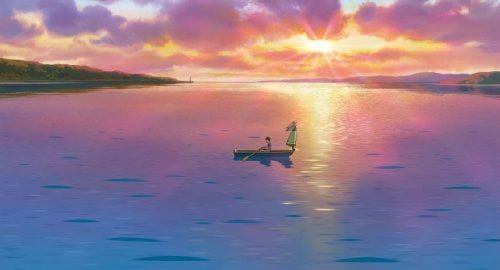When Marnie Was There

Twelve year-old Anna Sasaki (voice of Sara Takatsuki) suffers from asthma so her foster mom Yoriko (voice of Nanako Matsushima) sends her to a seaside fishing village to stay with relatives Kiyomasa (voice of Susumu Terajima) and Setsu Oiwa (voice of Toshie Negishi) to recover. Lonely Anna views it as another form of abandonment, but when she spies a stunning mansion across a marsh it seems familiar and it and the young blonde girl she's seen in an upper window begin to haunt her dreams. Continually drawn to the long empty house, Anna meets and forges a secret friendship with the girl, experiencing the place just like "When Marnie Was There."
Laura's Review: B-
The first animation from Studio Ghibli since founders Hayao Miyazaki and Isao Takahata released their last films comes from cowriter (with Keiko Niwa ("The Secret World of Arrietty") & supervising animator Masashi Ando )/director Hiromasa Yonebayashi ("The Secret World of Arrietty") adapting a Miyazaki recommended Joan G. Robinson novel. As would be expected from a hand drawn Ghibli film, the animation is stunning, with water and light coming to life and complex emotions rendered expertly and precisely on Anna's face. But although this ghost story is touching and its central message of empathy an important one, the movie's not up to Ghibli's best, failing to linger in the memory. This one's aimed at older kids, its heroine introduced as hating herself, believing she's a burden. Anna's closed herself off from schoolmates and Yoriko, who is clearly concerned. When she arrives at the Oiwas, the first thing she notices are the kids' crafts in their outer foyer, evidence of a family life she's never known. But her beautiful room with its scenic view and Kiyomasa's boisterous cheerfulness soon lift her spirits. Anna's less than gracious when accompanying a neighbor's child to a festival of lights, but once she's met Marnie, the strange little girl in the long blue dress, her respite takes on a welcome routine. We never do learn why a blue-eyed blonde resides in Japan (when her parents give a party, they're clearly Japanese) and Anna's jealousy when Marnie's courted by a young boy transcends the passion of deep friendship with homoerotic overtones, both odd notes in a children's story. Anna's guilt over medical bills doesn't jibe with her suspicion of her foster mom's financial aid on her behalf either. When Anna meets an artist, Hisako (voice of Hitomi Kuroki), who paints the Marsh House, pieces begin to fall into place and the parallels between the two girls come into focus. But Anna's connection to Marnie isn't as heartwarming as her realization of the one she's had along. "When Marnie Was There" will never be a Ghibli classic, but one hopes the studio weathers its transition so this labor intensive art form can continue. Yonebayashi is a talent worth nurturing. Grade:
Robin's Review: B
Anna is a solitary orphan girl living with her foster mother Yoriko. When she becomes ill, Anna is sent to stay with Yoriko’s sister and her husband in the country to get well. But she does not get along with the other children in the village and resumes her loner ways, incessantly making sketches on her pad. Her life will change when she meets a beautiful young girl and we find out what happened “When Marnie Was There.” Over the last decades I have seen many of the wonderful anime films that came out of Japan’s famous Studio Ghibli, but nowhere near all of them as I found out looking up the body of work from the studio. Ghibli founders, animation masters Hayao Miyazaki and Isao Takahata and producer Toshio Suzuki, have created such masterpieces as “Grave of the Fireflies (1988),” “Princess Mononoke (1996),” “Howl’s Moving Castle (2004)” and “The Wind Rises (2013)” among many others, most of which were directed by Miyazaki and Takahata. (Miyazaki claims he is now retired and the future of Studio Ghibli is, unfortunately, up in the air now.) What I hope is not the last anime feature from Ghibli, “When Marnie Was There” is directed by Hiromasa Yonebayashi and adapts the 1967 novel by Joan G. Robinson. The story is a simple one about a lonely girl who has gotten used to her isolation, finding solace in her drawing. One of her subjects, an abandoned villa on the other side of the bay from the town, shows a strange light from an upstairs window. When she investigates the next day, all she finds is a villa that has been empty a long time, This is where “When Marnie Was There” takes a turn with the introduction of the titular character and the story becomes a blend of ghost story and supernatural fairy tale that is beautifully told. Couple the story with the rich, hand-drawn animation from the master anime-makers and we have something special and loving. The film’s obvious audience is young girls everywhere because of its message of love and friendship. But, anyone who loves animated feature films (like me) will take pleasure, too.

